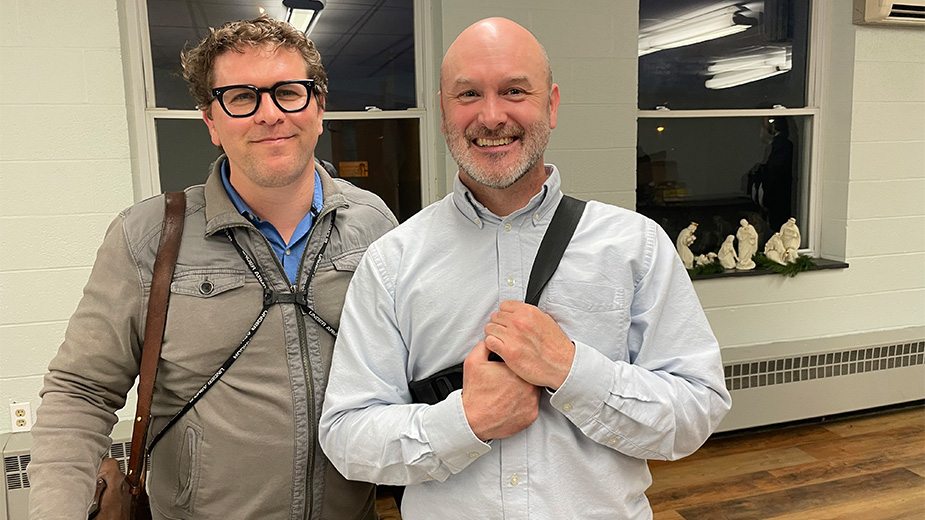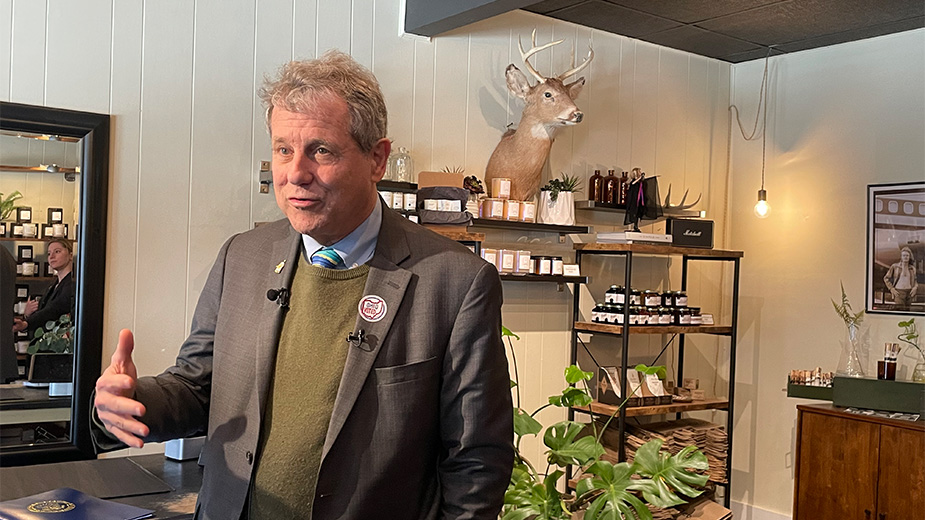They Make the Real Brier Hill Pizza
YOUNGSTOWN, Ohio – At St. Anthony of Padua Church, the parishioners start filing in early, very early, Friday mornings.
The first show up at 4 a.m. to start making the tomato-based sauce. The next group arrives an hour later to start making dough and folding boxes. And the final wave is in the kitchen by 7, ready to cut the dough, add toppings and bake.
It’s here that 25 or so parishioners carry on one of the neighborhood’s most venerated traditions: Brier Hill pizza.
Each week, they create and bake 500 or so pizzas, mostly from scratch, and sell them for $7 each, hot peppers and sausage adding 50 cents to the price. All the money taken in goes back to the church.
“It’s a good product and it’s authentically Italian. We have workers who come down here and work ourselves tired every week to do this,” says Marian Degenaro, who oversees the pizza sales.
Almost all the pizza makers grew up in the surrounding blocks, descendants of Italian immigrants to Youngstown. In their work, they perpetuate how the pizza was born: out of necessity.
Brier Hill pizza, named for the neighborhood settled by the city’s first Italian immigrants, is a simple dish made from what was available in almost every home: tomato sauce; peppers; flour, yeast and water for the dough and, if a family could afford it, grated cheese.
“It’s what was available in the households,” Degenaro says. “They were eating pasta a couple of times a week, so they were used to having that sauce and cheese around.”
The pizza is the same found in the Basilicata region of Italy, the arch of the country’s boot, whence many immigrants came to Youngstown.
The cheese traditionally used, notes Stephen Degenaro, Marian’s husband and a native of Brier Hill, is macaroni cheese – better known as pecorino Romano. In some instances, he says, an alternative topping known as mulig was used.
“If people were too poor to have cheese, they would use a mix of breadcrumbs and garlic that was fried,” he says. “It had the texture of the cheese they used and because of the garlic it would taste similar.”
Back then, when he was growing up, Stephen Degenaro continues, the pizza never carried the name by which it’s now known throughout the region.
“To us it was just pizza,” he says.
His wife picks up the narrative, explaining that the first time she ate pizza – any kind – was in the house of Stephen’s grandmother in Brier Hill.
“There weren’t pizza shops like there are now,” Marian says, noting that her family isn’t Italian. “She made it by hand for us. I had never eaten it before.
“It just wasn’t part of our menu,” she continues. “And I can tell you that she did it exactly the same way as we do it here.”
Since Marian started working for St. Anthony, Brier Hill is nearly the only style of pizza she eats. Just recently, she relates, she and Stephen were at a birthday party where she ate a slice of pepperoni pizza for the first time in three years.
Fred Ross, a lifelong resident of Brier Hill, notes that Brier Hill pizza isn’t exclusive to the Youngstown area.
“It’s a widespread piece of pastry that was made everywhere, from down the river in the Pittsburgh area all the way up through here to the Cleveland area,” he explains. “Because of the poverty involved, it was made by immigrants – not just Italians – in the areas.”
Marian Degenaro is sure other Italian communities across the country have similar dishes. After all, Italian immigrants didn’t come exclusively to Youngstown.
“I’m sure that if you went to New Jersey or any other city with a Little Italy neighborhood where many settled, you’d find something similar,” she says.
Pizza sales at St. Anthony began 35 years ago. At the time, the tomatoes and peppers were grown behind the church. Today, many of the raw ingredients are purchased. Parishioners make the sauce each Friday, while peppers are lightly roasted and either set aside for use that day or frozen to build up inventory for the colder months.
“We always try to have enough in the freezer to last us until the next gardening season. This year we filled two freezers, about 25 bushels, with nothing but hot peppers,” Stephen Degenaro relates.
A busy day can see 200 pounds of dough made, he says. Each pizza is made from 12 ounces of dough, carefully cut, weighed and balled up before being flattened and put into a pan greased with lard.
In one room, the tomato sauce is made in a modern vat and separated into aluminum saucepots that date from the 1950s. A volunteer ladles it onto the pressed dough. The sauce is thin enough for him to spread without utensils, instead just spinning and tilting the tray to cover the dough.
He then passes it to his right where peppers, either strips of bell peppers or hot pepper rings, are added. Next, the cheese (and occasionally sausage) is added before being sent off to bake in one of four ovens.
The newest oven is only a few years old but the oldest has been in use for decades. Two bakers monitor the pizzas. About halfway through their baking time they move them from trays to a pizza stone to crisp the bottoms. Once fully cooked, the pizzas are wheeled out to the cafeteria and put in the middle of four giant fans to cool.
“One of the hardest parts of my job,” Marian Degenaro explains, “is coordinating what needs to be made when. If someone says they’ll pick up their pizza at 10, we aren’t going to make it at 8 and let it sit. We want it to be warm for them.”
In the 1950s and ’60s, pizzerias began popping up around Youngstown and many began carrying the classic dish, Ross says. It was then that the pizza went from being just a traditional meal at home to Brier Hill pizza.
Anthony Pellegrini, owner of Wedgewood Pizza in Boardman, attended St. Anthony’s school and grew up with the traditional pizza at home, his uncle’s pizza shop and in the school.
“Coming from an Italian family, you had staples every Sunday, whether it was pasta or pizza and all those other dishes. And you loved them,” he says. “It was what was expected.”
When Pellegrini opened his pizzeria, offering a Brier Hill pizza was not an option. It was a requirement.
“We’re all Italian-heritage pizza shops, so it’s very important to us. From a mom-and-pop shop perspective, it’s important to carry that,” he says. “It’s almost sacrilegious if you don’t.”
One of the nearly imperceptible differences, however, is that Pellegrini opts for diced peppers rather than the traditional strips.
“Everyone did it a little different with the same ingredients,” he relates. “Some did it with diced. Some did it with strips. Some used bell peppers and some used hot peppers.”
Even the national pizza chains, such as Pizza Hut and Papa John’s, have begun offering their versions of Brier Hill pizza in the Mahoning Valley.
“Do I think you could survive without a Brier Hill pizza around here?
Yes, absolutely. Should you, though? Absolutely not,” says Cocca’s Pizza owner Steve Cocca. “The truth of the matter is that any good business person will put that on the menu because it’s an easy sell.”
The traditionalists in the area, though, know that those versions will never stack up to those based on the recipes their families carried from the Old World.
“They’re just trying to capitalize. I won’t knock them for that because it’s business,” says Ross, the lifelong Brier Hill resident. “But they’re just imitating.”
Tradition sets the pizzas apart, Degenaro says, especially at St. Anthony.
“It’s wonderful that there’s a market for it. Everyone in the Valley recognizes it as Brier Hill and it’s nice that people have options for it,” she says. “But prejudicially, I’d say that ours is better and the most authentic.”
A few years ago, Degenaro says, she considered suspending making pizza during summer when sales dipped in the midst of the slew of ethnic festivals held in Youngstown. But Monsignor Michael Cariglio wouldn’t hear of it.
“He said, ‘It’s all about the tradition,’ not just the money we make,” she says. “We continue whether business is bad or business is good,” she says. “It’s the reason for being.”
For many at St. Anthony, that message rings true.
From her 20-plus years working the pizza sales, Degenaro has plenty of stories that illustrate what it means to the parishioners.
Shortly after she began, a woman making dough passed out at her station and the paramedics were called. When she regained consciousness, the paramedics tried to take her to the hospital.
“She asked in her Italian-accented broken English, ‘What’re you doing’?’ They wanted to take her to the hospital, but she said, ‘Hell, no,’ ” Degenaro recalls. “We didn’t let her work much more, but she finished out the day in a chair watching. And the next week she was right back in there making pizza.”
A doctor told one of the current bakers that he had to stop working in the hot, cramped kitchen. He’s still comes in every Friday to do his job. Sometimes his station partner makes him take a break.
“When he’s out there, he sits there with his head down,” she says, “and if you fuss over him, he starts crying sometimes. He just can’t give it up. We are made of tough stuff here. We enjoy what we do.”
Pictured: Mary Frasco and George Cepin prepare the dough for St. Anthony’s Brier Hill pizza.
Copyright 2024 The Business Journal, Youngstown, Ohio.



